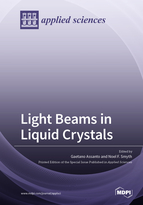Unique Features of Nonlocally Nonlinear Systems with Oscillatory Responses
Round 1
Reviewer 1 Report
This review paper considers a coupled system, which governs the propagation of optical solitary waves. The coupled system consists of a NLS type equation for the electric field amplitude coupled with a nonlocal equation, which describes the response of medium to the electric field. The refractive index varies with power and this nonlinear response results in the existence of solitary waves. Many optical media are described by this system including nematic liquid crystals, thermal media, photo-refractive crystals. In the case of thermal media the nonlocal equation describes heat diffusion so for simplicity I’ll call it a heat equation, even though the physical context varies.
The authors consider a variant of this well studied system, for negative dielectric anisotropy, where the signs of the heat equation are swapped-effectively replacing a source term by a sink term. This variant system is justified by the experimental work in [29]. However [29] is an arxiv preprint submitted to the repository in 2014-has it been published in a peer reviewed journal? The authors have not presented peer reviewed evidence that the system (1)-(2) considered actually describes real physical systems or is merely of mathematical interest.
The authors review numerical solutions, approximate solutions, modulational instability, multi-peak solutions and experimental work. It’s a comprehensive review and may be publishable, after some major revisions.
Some of the content included is from papers that have not been published themselves. These are references [26], [29] and [47], the first two being in the arxiv repository while [47] is just a place holder for future work. I believe that a review paper should only contain content that has been independently reviewed and approved for publication, hence all content and references to [26], [29] and [47] need to be removed.
Hence the inclusion of the whole section VI “Optical beams in NLC with negative dielectric anisotropy” in the paper should be reconsidered and Section VI.C “Experimental results of the soliton in NLC with negative dielectric anisotropy”, should certainly be removed as it reports the results on the unpublished paper [29].
Section V “Perturbation-Iteration method” also needs to be re-written removing the figures and theory from the unpublished paper [26].
Author Response
Please see the attachment
Author Response File: ![]() Author Response.pdf
Author Response.pdf
Reviewer 2 Report
This paper presents a review of results demonstrating the modulational instability and existence of solitons in a system of two equations, one of which is the Schroedinger equation with a potential, and the second one is the inhomogeneous (driven) Helmholtz equation for the potential. The system is a model for the light propagation in nematic liquid crystals. The review may be, in principle, relevant, but it should be better organized. First, when various examples of solitons and soliton families are displayed in Figs. 8 - 15, captions to all figure should clearly state what solitons are stable and which ones are not, as the stability is the most essential issue in this context. In the current text, statements concerning the stability are not clearly presented, but are rather hidden in the depth of the text.
Further, it seems strange that the review ignores the realization of the same system in a different physical setting, viz., a two-component Bose-Einstein condensate interacting with electromagnetic field coupling two atomic states that compose the condensate. In that setting, not only one-dimensional solitons were studied, but also two-dimensional ones: Phys. Rev. Lett. 115, 023901 (2015); Phys. Rev. A 94, 053611 (2016); Phys. Rev. A 99, 023610 (2019).
It is recommended to fix the above-mentioned issues.
Author Response
Please see the attachment.
Reviewer 3 Report
My review is in the attached pdf file.
Comments for author File: ![]() Comments.pdf
Comments.pdf
Author Response
Please see the attachment.
Author Response File: ![]() Author Response.pdf
Author Response.pdf
Round 2
Reviewer 1 Report
The authors have addressed my previous comments and I recommend the paper be accepted
Author Response
Many thanks.
Reviewer 3 Report
My review is in the attached pdf file.
Comments for author File: ![]() Comments.pdf
Comments.pdf
Author Response
Please see the attachment.
Author Response File: ![]() Author Response.pdf
Author Response.pdf





